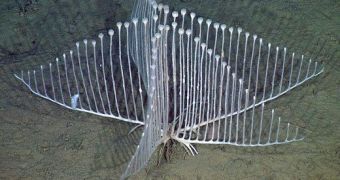Marine researchers first became acquainted with carnivorous sponges about 17 years ago, but this does not mean that they know everything about them.
Quite the contrary: it was only recently that a team of scientists made it public news that two such sponges collected from the waters of California's Monterrey Bay back in 2000 were in fact a new species, previously unknown to science.
Because this new type of meat-eating sponges is strikingly similar to a harp or a lyre turned topsy-turvy, the researchers decided to call it the “harp sponge.”
Still, its slightly more official name is to remain “Chondrocladia lyra.”
According to Our Amazing Planet, these carnivorous sponges were found by these specialists from the Monterrey Bay Aquarium Research Institute at a depth of roughly 11,000 feet (3,500 meters).
Invertebrate biologist Lonny Lundsten commented on these findings as follows: “We were just amazed. No one had ever seen this animal with their own eyes before.”
“We've seen only 1 percent of Monterrey Bay and it's still one of the most well-studied regions of Earth in deep water. I can look out over the waters from MBARI and imagine thousands of species out there yet to be discovered,” the specialist went on to add.
This carnivorous sponge's feeding behavior is interesting, to say the least: it uses its limbs in order to trap any crustaceans that happen to be passing by, and later on, it engulfs its prey in a thin membrane and waits for it to be digested.
As far as reproduction goes, it seems that these meat-eating sponges rely on spermatophores (i.e. condensed packages of sperm) in order to produce a new generation.
Thus, the spermatophores are simply released into the water currents. Later on, they are captured by other sponges nearby, whose bodies they infiltrate.
You can check out this meat-eating harp sponge in the video below.

 14 DAY TRIAL //
14 DAY TRIAL // 